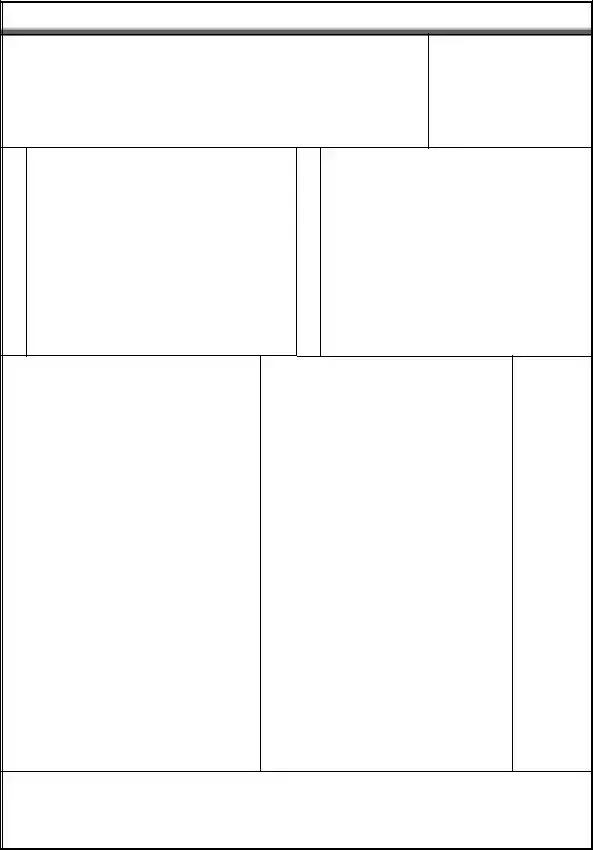ONSITE SYSTEM INSPECTION FORM
Inspection Overview:
Preliminary system information
Inspection of treatment tanks
Absorption system inspection
Disposal/conveyance system assessment
Identification of any alternative technology approved components
-Requires additional inspection
Client Name: _________________________
Different from owner? () Yes () No
Client Address: _______________________
____________________________________
____________________________________
____________________________________
Contact Method:
Home tel. __________________________
Work tel. __________________________
E-mail ____________________________
Inspector Name:______________________
Date: _______________________________
ISSDS Address (including municipality):
____________________________________
____________________________________
____________________________________
New Jersey Coordinate: Block: ___ Lot:___
Was GPS used? () Yes |
() No |
Preliminary Information:
Weather: ____________________________
Last Precipitation:_____________________
Age of System: _______________________
Type of Dwelling?
() Residential Number of Bedrooms: ___
() Non Residential Describe:___________
How many systems are being inspected? List any commercial activities or high impact hobbies:
___________________________________
___________________________________
___________________________________
Describe prior problems and/or repair history including soil fracturing or use of chemical additives. Include dates and explain why the remedial measures have been applied to the system (if available):
___________________________________
___________________________________
___________________________________
Date file review requested with administrative authority:
___________________________________
Is there a site plan or septic map available? Is the dwelling currently being occupied?
If so, how many occupants? ________
If no, date last occupied? __________
If there is a washing machine, is it connected to a separate greywater disposal system?
Is the dwelling free of additional greywater systems?
Is the dwelling free of garbage disposal systems?
Is the dwelling free of sump pump discharges to the system?
Is the dwelling free of any historical sewage back ups into the structure?
Does all sewage enter the septic system and no type of sewage bypass exists?
Septic Tank Pumping:
Is the septic tank pumped regularly? Frequency: _____________________
Date of Last Pumping: ____________
Was file review completed prior to inspection?
If no, explain why below.
Yes No () ()
() ()
() ()
() ()
() ()
() ()
() ()
() ()
() ()
() ()
Comments: __________________________________________________________________________
___________________________________________________________________________________
___________________________________________________________________________________
___________________________________________________________________________________

Treatment Tank: |
|
|
|
|
|
|
Yes |
No |
() Septic Tank() Other |
|
Main tank lid opened for inspection? |
|
|
() |
() |
() Greywater |
() Multi-Compartment:#______ |
Liquid level below the tank’s inlet invert? |
|
() |
() |
|
|
|
|
Liquid level below the tank’s outlet invert? |
|
() |
() |
Name the material of the system? |
|
Treatment tank pumped for this |
|
|
|
|
() Concrete |
() Block |
|
inspection? |
|
|
() |
() |
() Steel |
() Other___________________ |
Are all portions of the tank(s) clear of |
|
|
|
|
|
|
|
|
structures like a deck or a driveway? |
|
() |
() |
Approximate treatment tank volume: ______ gal. |
Is the area clear of evidence that sewage |
|
|
|
|
|
|
|
has surfaced above the treatment tank? |
|
() |
() |
Evaluate the conditions of tank below: |
|
Does water flow unimpeded from the |
|
|
|
|
|
|
|
|
treatment tank? |
|
|
() |
() |
Satisfactory |
Unsatisfactory |
N/A |
Is an effluent filter a part of the system? |
|
|
() |
() |
Top and Lids |
() |
() |
() |
If yes, does it appear properly |
|
|
|
|
Inlet Baffle |
() |
() |
() |
maintained? |
|
|
() |
() |
Outlet Baffle |
() |
() |
() |
Are there any other types of accessory |
|
|
|
|
Cracks or Leaks |
() |
() |
() |
units present? |
|
|
() |
() |
Sewage Flow from |
|
|
Depth to top of tank:____________ inches |
|
|
|
Structure |
() |
() |
() |
Depth to top of tank access: ______ inches |
|
|
|
|
|
|
|
Comments: ________________________ |
|
|
|
|
|
|
|
_________________________________ |
|
|
|
|
|
|
|
|
|
|
|
|
Absorption Area: |
|
|
|
|
|
|
|
|
Name the type of the absorption system? |
|
|
|
|
|
|
|
() Disposal Bed |
() Disposal Trench |
|
|
|
|
|
|
() Seepage Pit |
() Mounded |
|
|
|
|
|
|
|
() Other |
|
|
|
|
|
|
|
|
|
Was the absorption system located? |
() Yes |
() No |
If no, explain below. |
|
|
|
|
Are inspection ports present? |
() Yes |
() No |
|
|
|
|
|
If yes, how many? _________________________________________________ |
|
|
|
|
Were the inspection ports checked? |
() Yes* |
() No |
() N/A *All levels observed must be |
|
included in report |
|
|
|
|
|
|
|
|
Was a separate probe dug in the absorption area to confirm the observations in the inspection ports? |
|
|
|
|
|
|
() Yes |
() No |
() N/A |
Is the area of the absorption system free of sewage odors? |
() Yes |
() No |
|
|
Does sewage flow from the treatment tank to the absorption system without flowing back? |
|
|
|
|
|
|
|
|
|
() Yes |
() No |
|
|
Is the area above or near any of the system components free from visible signs of effluent or sewage? |
|
|
|
|
|
|
() Yes |
() No |
|
|
Are the areas at or near the inlet invert of any absorption area component free of visible signs of sewage or
effluent? |
() Yes |
() No |
Are areas above or near system components free of lush vegetation? |
() Yes |
() No |
If exposed, is the distribution box in satisfactory condition? |
() Yes |
() No () N/A |
If not exposed, explain why not: ______________________________________________________
Is the area directly over any part of the absorption system free of any evidence of, large objects (cars, pools,
etc.)?() Yes () No () N/A
Comments: __________________________________________________________________________
___________________________________________________________________________________
___________________________________________________________________________________
___________________________________________________________________________________
___________________________________________________________________________________
___________________________________________________________________________________
Sketch the approximate system location in this space provided:
|
Dosing or Pump Tank: |
|
Yes |
No |
N/A |
|
|
|
Does the system contain a pump tank? |
() |
() |
() |
|
|
|
Is the pump operating? |
|
() |
() |
() |
|
|
|
Do the alarm(s) on the pump work? |
() |
() |
() |
|
|
|
Is the pump elevated above the tank floor? |
() |
() |
() |
|
|
|
Is the lid in satisfactory condition? |
() |
() |
() |
|
|
|
Is the tank in satisfactory condition? |
() |
() |
() |
|
|
|
Is the tank free of accumulated solids? |
() |
() |
() |
|
|
|
|
|
|
|
|
|
|
|
|
|
|
|
|
|
|
|
|
|
|
|
|
|
|
|
Summary: |
Satisfactory |
Satisfactory |
Unsatisfactory |
Requires Additional |
N/A |
|
|
|
|
with Concerns |
|
Investigation |
|
|
|
Condition of the treatment |
|
|
|
|
|
|
|
tank(s) |
() |
() |
() |
() |
() |
|
|
Condition of the conveyance |
|
|
|
|
|
|
|
and pump system(s) |
() |
() |
() |
() |
() |
|
|
Condition of the absorption |
|
|
|
|
|
|
|
area(s) |
() |
() |
() |
() |
() |
|
|
Condition of any accessory |
|
|
|
|
|
|
|
components |
() |
() |
() |
() |
() |
|
Comments: __________________________________________________________________________
___________________________________________________________________________________
___________________________________________________________________________________
___________________________________________________________________________________
___________________________________________________________________________________
___________________________________________________________________________________
___________________________________________________________________________________
Health Department Reporting:
Note if any of the following conditions were observed during the inspection:
() 1. Ponding or breakout of sewage or effluent onto the surface of the ground
() 2. Seepage of sewage or effluent into portions of buildings below ground
() 3. Backup of sewage into the building served which is not caused by a physical blockage of the internal plumbing
() 4. Any manner of leakage observed from or into septic tanks, connecting pipes, distribution boxes and other components that are not designed to emit sewage or effluent
Pursuant to N.J.A.C. 7:9A-3.4 notification of any observation that is consistent with a condition noted above must be reported to the local administrative authority within 24 hours of the observation. Regardless of observations made, a copy of this report must be provided to the local administrative authority within 10 days of the issuance of this report.
If encountered, describe all observed noncompliant conditions encountered during this inspection:
___________________________________________________________________________________
___________________________________________________________________________________
___________________________________________________________________________________
___________________________________________________________________________________
___________________________________________________________________________________
Customer Authorization:
I authorize “The Company” to enter the above listed property for the purpose of performing a sub-surface sewage disposal system inspection. I authorize “The Company” to expose parts of the system if required, to determine location and condition. I understand that “The Company” relies on information supplied by the owner(s) of the listed property or their agent and the local administrative authority in the evaluation of the sub-surface disposal system. I authorize “The Company” to provide this form to all parties as required.
Customer signature: _____________________ |
Printed name: |
_____________________________ |
Inspector’s signature: ____________________ |
Printed name: |
_____________________________ |
Disclaimer:
Based on today’s observations and the information provided by the owner(s) or their agent, “The Company” submits this sub-surface sewage disposal system inspection form. The inspection is based on the current condition of the onsite sewage disposal system. “The Company” makes no representation that the system was designed, installed or meets N.J.A.C. 7:9A-1.1 et seq.. “The Company” has not been retained to warrant, guarantee, or certify the proper functioning of the system for any period of time. Because of numerous factors (usage, soil type, installation, maintenance, etc.) which affect the proper operation of a sub-surface disposal system, as well as the inability of “The Company” to supervise or monitor the use and maintenance of the system, this form shall not be construed as a warranty by “The Company” that the system will function properly for any prospective buyer. “The Company” disclaims any warranty, either expressed or implied, arising from the inspection of the septic system.
This form was developed as a cooperative effort of:
Pennsylvania/New Jersey Sewage Management Association;
Rutgers Cooperative Extension New Jersey Agricultural Experiment Station; and
The New Jersey Department of Environmental Protection Septic System Inspection Protocol Subcommittee




